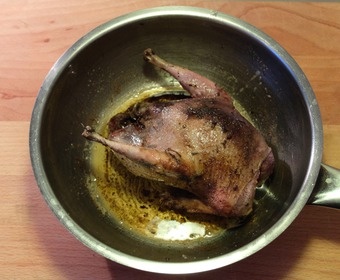
COOKING WILD FOWL
- Wide variation in flavor
- Rarely better on day two
- Keep an eye on your cooking times
- The skin will shrink
- Go for the breast fillets
The meat from game birds is high in flavor, most species – there’s a huge amount of variation – have an elegant gamey flavor that’s stronger than in game animals. Wild fowl rarely tastes better on day two. Cook the right amount and intend to finish it.
Cooking times vital
Cooking times and temperatures are crucial as the lean meat will dry out if cooked for too long. Overcooked wild fowl easily takes on a dull, liver flavor. But as long as you’re careful, it isn’t difficult to cook a juicy, tender, beautiful bird.
How to cook wild fowl
To get an attractive surface, high in flavor, first cook at a high temperature. Then lower the heat to retain the juices in the meat until the right internal temperature is reached.
Wild birds have a drier and more elastic protein in the skin than domesticated birds. The skin of the bird will shrink as you cook it. One disadvantage of this is that the skin will squeeze out liquid from the meat. Try this method:
- Cut into the skin before cooking, make small cuts with a sharp knife across the breast, thighs and where the legs and wings meet.
- Add fat under the skin.
With or without skin
Birds in the grouse family and also quail have a very thin and lean skin that you can easily remove before cooking. With wild ducks and other fatty birds, you can either cut the skin or remove it.
Time depends on size
Size is more important than the type of bird when calculating cooking times. A large wild duck and a small pheasant can be the same size and will need about the same time in the pan or the oven. Use a thermometer.
- Preheat the oven to 125-140°C.
- When putting the birds in the oven, it’s a good idea to put them with one breast side downwards. After half the time turn them round and place the bird on the other breast.
- If cooking a bird whole, remember that it’s hard to get the whole bird to the right temperature at the same time. The meat in the breast fillets will be cooked more quickly than the meat in the thighs, so you often have to sacrifice one for the other. (When cooking wild fowl – which often have small legs with dry, dark meat – it’s better to focus on the breast meat.)
- After the oven: Season the bird slightly before placing in aluminum foil to rest for 15 minutes or more.
Never overcook
Overcooked birds can take on a metallic taste of liver. Avoid this by being keeping a watchful eye on the internal temperature. Use a quick and sensitive thermometer and remember the 4% rule.
Cooked whole or fillets?
Most people choose to cook their birds whole or to cut them up and make a stew. But if you have a bit of patience, cutting and cooking the breast and thighs separately, or mincing the meat are worth doing.
Cut bigger birds into pieces for even cooking
Try this method: Fry the breast as if it was a beef fillet. Thin breast fillets without bones – which insulate against the heat – just need a few minutes of frying on each side. Thighs and wings need longer. You can cook them in water or in fat (confit) until the meat is dark and falling apart and coming off the bones.
Serve with the lean meat from the breast fried as fillets and the meat falling off the legs and wings on the same plate. This gives you perfect contrasts in texture and flavor.
Cooking game stock
The bones and membranes of a wild bird aren’t as rich in flavor as you might think. Have patience and let the stock simmer for hours with the bones. In restaurant kitchens stock often cooks for one or two days.
One professional tip is to combine your wild fowl stock with ordinary chicken stock. Chicken stock has an ability to bring out the best in practically everything.
Temperatures may vary
Most wild fowl are wonderfully pink and juicy at an internal temperature of 55-56°C. But the amount of cooking varies from species to species. Wild duck is pink at 52-53°C while capercaillie is better at 67-68°C so as not to be dry. Check the list of temperatures.
Wild fowl go well with:
Wild fowl – slightly depending on the type – go well with onion, garlic, bacon, butter, thyme, redcurrant jelly, pistachios, mushrooms and other flavors that bring the forest and the wild onto the dining table.


